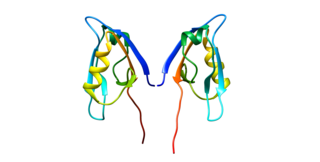
Interleukin 3 (IL-3) is a protein that in humans is encoded by the IL3 gene localized on chromosome 5q31.1. Sometimes also called colony-stimulating factor, multi-CSF, mast cell growth factor, MULTI-CSF, MCGF; MGC79398, MGC79399: after removal of the signal peptide sequence, the mature protein contains 133 amino acids in its polypeptide chain. IL-3 is produced as a monomer by activated T cells, monocytes/macrophages and stroma cells. The major function of IL-3 cytokine is to regulate the concentrations of various blood-cell types. It induces proliferation and differentiation in both early pluripotent stem cells and committed progenitors. It also has many more specific effects like the regeneration of platelets and potentially aids in early antibody isotype switching.

Interleukin 8 is a chemokine produced by macrophages and other cell types such as epithelial cells, airway smooth muscle cells and endothelial cells. Endothelial cells store IL-8 in their storage vesicles, the Weibel-Palade bodies. In humans, the interleukin-8 protein is encoded by the CXCL8 gene. IL-8 is initially produced as a precursor peptide of 99 amino acids which then undergoes cleavage to create several active IL-8 isoforms. In culture, a 72 amino acid peptide is the major form secreted by macrophages.

Chemokine ligand 20 (CCL20) or liver activation regulated chemokine (LARC) or Macrophage Inflammatory Protein-3 (MIP3A) is a small cytokine belonging to the CC chemokine family. It is strongly chemotactic for lymphocytes and weakly attracts neutrophils. CCL20 is implicated in the formation and function of mucosal lymphoid tissues via chemoattraction of lymphocytes and dendritic cells towards the epithelial cells surrounding these tissues. CCL20 elicits its effects on its target cells by binding and activating the chemokine receptor CCR6.

Chemokine ligand 19 (CCL19) is a protein that in humans is encoded by the CCL19 gene.

C-X-C motif chemokine 5 is a protein that in humans is encoded by the CXCL5 gene.

The interleukin 4 receptor is a type I cytokine receptor. It is a heterodimer, that is, composed of two subunits. IL4R is the human gene coding for IL-4Rα, the subunit which combines with either common gamma chain or with IL-13Rα1.

Interleukin 8 receptor, beta is a chemokine receptor. IL8RB is also known as CXCR2, and CXCR2 is now the IUPHAR Committee on Receptor Nomenclature and Drug classification-recommended name.

Chemokine receptor 6 also known as CCR6 is a CC chemokine receptor protein which in humans is encoded by the CCR6 gene. CCR6 has also recently been designated CD196. The gene is located on the long arm of Chromosome 6 (6q27) on the Watson (plus) strand. It is 139,737 bases long and encodes a protein of 374 amino acids.

Interleukin-10 receptor subunit alpha is a subunit for the interleukin-10 receptor. IL10RA is its human gene.

C-C chemokine receptor type 11 is a protein that in humans is encoded by the CCRL1 gene.

Interleukin-12 receptor, beta 1, or IL-12Rβ1 in short, is a subunit of the interleukin 12 receptor and the interleukin 23 receptor. IL12RB1, is the name of its human gene. IL-12Rβ1 is also known as CD212.

Interleukin 5 receptor, alpha (IL5RA) also known as CD125 is a subunit of the Interleukin-5 receptor. IL5RA also denotes its human gene.

Interleukin-1 receptor accessory protein is a protein that in humans is encoded by the IL1RAP gene.

Interleukin 9 receptor (IL9R) also known as CD129 is a type I cytokine receptor. IL9R also denotes its human gene.

Interleukin-18-binding protein is a protein that in humans is encoded by the IL18BP gene.

Interleukin 17 receptor A, also known as IL17RA and CDw217, is a human gene.

Interleukin 18 receptor accessory protein, also known as IL18RAP and CDw218b, is a human gene.

Interleukin 3 receptor, alpha (IL3RA), also known as CD123, is a human gene.

The interleukin-18 receptor 1 (IL-18R1) is an interleukin receptor of the immunoglobulin superfamily. IL18R1 is its human gene. IL18R1 is also known as CDw218a.

Interleukin-7 receptor subunit alpha (IL7R-α) also known as CD127 is a protein that in humans is encoded by the IL7R gene.























